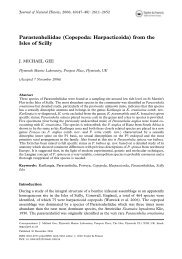An Updated Classification of the Recent Crustacea
An Updated Classification of the Recent Crustacea
An Updated Classification of the Recent Crustacea
You also want an ePaper? Increase the reach of your titles
YUMPU automatically turns print PDFs into web optimized ePapers that Google loves.
and Dalens (1999) in that we include six families.<br />
Roman and Dalens do not recognize <strong>the</strong> family <strong>An</strong><strong>the</strong>luridae<br />
and <strong>of</strong> course could not have known<br />
about <strong>the</strong> Expanathuridae and Leptanthuridae.<br />
SUBORDER MICROCERBERIDEA<br />
Wägele (1983) placed <strong>the</strong> family Microcerberidae<br />
within <strong>the</strong> Aselloidea; Brusca and Wilson (1991)<br />
considered <strong>the</strong> Microcerberoidea <strong>the</strong> sister group to<br />
<strong>the</strong> Asellota and consequently suggested <strong>the</strong>y not<br />
be included among <strong>the</strong> Asellota. Our treatment <strong>of</strong><br />
<strong>the</strong> family as belonging to its own suborder and<br />
superfamily follows Bowman and Abele (1982) but<br />
is also in keeping with <strong>the</strong> suggestion <strong>of</strong> Brusca and<br />
Wilson (1991). Additionally, we now treat <strong>the</strong><br />
monotypic family Atlantasellidae in this suborder<br />
on <strong>the</strong> recommendation <strong>of</strong> G. D. F. Wilson (pers.<br />
comm.).<br />
SUBORDER FLABELLIFERA<br />
Brusca and Wilson (1991) showed that <strong>the</strong> Flabellifera<br />
was a paraphyletic grouping, a finding that<br />
has been suggested also by o<strong>the</strong>r workers. Wägele<br />
(1989) (rebutted to some degree by Wilson, 1996)<br />
argued for dividing <strong>the</strong> flabelliferan families into<br />
two somewhat smaller groups, <strong>the</strong> Cymothoida<br />
and Sphaeromatidea (see Wägele, 1989). Wägele<br />
would remove from <strong>the</strong> Flabellifera <strong>the</strong> family Atlantasellidae<br />
(which he considers an Aselloidea).<br />
The families Aegidae, <strong>An</strong>uropidae, Argathonidae,<br />
Cirolanidae, Corallanidae, Cymothoidae, and Tridentellidae<br />
would belong to his grouping Cymothoida<br />
Leach, 1814. The remaining families (Bathynataliidae,<br />
Hadromastacidae, Keuyphyliidae, Limnoriidae,<br />
Phoratopodidae, Plakarthriidae, Serolidae,<br />
Sphaeromatidae, and Tecticepitidae) he would<br />
place in <strong>the</strong> Sphaeromatoidea. Thus, <strong>the</strong> two most<br />
current and most ambitious schemes <strong>of</strong> isopod phylogeny,<br />
although agreeing in some respects, do not<br />
agree even closely on how to treat <strong>the</strong> former flabelliferan<br />
families (see also Brandt et al., 1999, for<br />
a comparison <strong>of</strong> phylogenetic hypo<strong>the</strong>ses <strong>of</strong> sphaeromatoid<br />
families in light <strong>of</strong> <strong>the</strong> fossil family<br />
Schweglerellidae). Roman and Dalens (1999) recognize<br />
<strong>the</strong> Flabellifera, and divide it into three superfamilies:<br />
Cirolanoidea (seven families), Sphaeromatoidea<br />
(two families), and Seroloidea (two<br />
families). We have retained <strong>the</strong> Flabellifera for <strong>the</strong><br />
current classification, knowing that this assemblage<br />
cannot be considered monophyletic, and for now,<br />
we have avoided <strong>the</strong> use <strong>of</strong> superfamilies. <strong>Recent</strong><br />
fossil finds (see Brandt et al., 1999) have pushed<br />
back <strong>the</strong> origin <strong>of</strong> some former flabelliferan isopods,<br />
indicating that <strong>the</strong> sphaeromatoid isopods, at<br />
least, are <strong>of</strong> Late Jurassic ancestry or older.<br />
Within <strong>the</strong> Flabellifera, <strong>the</strong> following changes<br />
have been incorporated (listed alphabetically by<br />
family): <strong>An</strong>cinidae (elevated to family status by N.<br />
L. Bruce, 1993), Argathonidae (removed per R.<br />
Brusca, pers. comm.), Bathynomidae (removed per<br />
B. Kensley, pers. comm.), Excorallanidae (removed<br />
per B. Kensley, pers. comm.), Hadromastacidae (described<br />
by Bruce and Müller, 1991), Lynseiidae (described<br />
by Poore, 1987; removed per Cookson and<br />
Poore, 1994; see also Bruce, 1988), Protognathiidae<br />
(described by Wägele and Brandt, 1988; moved<br />
from Gnathiidea per R. Brusca and also G. Wilson,<br />
pers. comm.), Tecticepitidae (originally described as<br />
a subfamily by Iverson, 1982; elevated to family<br />
status by N. L. Bruce, 1993), and Tridentellidae<br />
(described by Bruce, 1984).<br />
N. L. Bruce (1993) presented a key to <strong>the</strong> known<br />
flabelliferan families, reappraised <strong>the</strong> family Sphaeromatidae<br />
Latreille (a family in ra<strong>the</strong>r dire need <strong>of</strong><br />
internal revision; see Harrison and Ellis, 1991), and<br />
recognized as families <strong>the</strong> <strong>An</strong>cinidae Dana and Tecticipitidae<br />
Iverson.<br />
G. Poore (pers. comm.) informs us that <strong>the</strong> Aegidae<br />
is correctly attributed to White (1850) ra<strong>the</strong>r<br />
than to Leach (<strong>the</strong>re are no families mentioned in<br />
<strong>the</strong> only paper that Leach published in 1815, <strong>the</strong><br />
date given in Bowman and Abele for this family).<br />
He also informs us that <strong>the</strong> families <strong>An</strong>cinidae, Cirolanidae,<br />
and Serolidae are correctly attributed to<br />
Dana (1852) instead <strong>of</strong> 1853 (as in Bowman and<br />
Abele, 1982).<br />
Bowman and Abele (1982) used <strong>the</strong> spelling <strong>An</strong>uropodidae<br />
for this isopod family, while noting<br />
(1982: 21) that <strong>the</strong> tanaid family <strong>An</strong>uropodidae Băcescu<br />
was a homonym <strong>of</strong> <strong>the</strong> isopod family <strong>An</strong>uropodidae<br />
Stebbing. ICZN Opinion 1357 (ICZN,<br />
1985b) dictated that <strong>the</strong> spelling <strong>of</strong> <strong>the</strong> isopod family<br />
should be <strong>An</strong>uropidae to remove <strong>the</strong> homonymy,<br />
and thus we use <strong>An</strong>uropidae as <strong>the</strong> correct<br />
spelling <strong>of</strong> this isopod family.<br />
The Plakarthriidae Hansen is, according to G.<br />
Poore (pers. comm.), ‘‘an effective replacement<br />
name for Chelonidiidae Pfeffer, 1887, but is conserved<br />
under ICZN article 40’’; Dr. Poore suggests<br />
that <strong>the</strong> date 1887 should follow Hansen, 1905, in<br />
paren<strong>the</strong>ses, as Plakarthriidae Hansen, 1905<br />
(1887).<br />
SUBORDER ASELLOTA<br />
According to G. Wilson and G. Poore (pers.<br />
comm.), <strong>the</strong> currently recognized superfamilies <strong>of</strong><br />
<strong>the</strong> Asellota are ei<strong>the</strong>r poly- or paraphyletic (see<br />
also Wilson, 1987) and will not stand <strong>the</strong> test <strong>of</strong><br />
time. Roman and Dalens (1999) treat <strong>the</strong> Asellota<br />
as being comprised <strong>of</strong> four superfamilies (down one<br />
from Bowman and Abele, 1982; <strong>the</strong> Protallocoxoidea<br />
and its single family, Protallocoxidae, have<br />
been removed). We have followed this arrangement<br />
here, recognizing <strong>the</strong> superfamilies Aselloidea, Stenetrioidea,<br />
Janiroidea, and Gnathostenetroidea.<br />
The superfamily Pseudojaniroidea, proposed by<br />
Wilson (1986), has been removed at his suggestion<br />
(G. Wilson, pers. comm.; see also Serov and Wilson,<br />
1999). Its former family, <strong>the</strong> Pseudojaniridae,<br />
has been transferred to <strong>the</strong> Stenetrioidea following<br />
<strong>the</strong> revision <strong>of</strong> <strong>the</strong> Pseudojaniridae by Serov and<br />
Wilson (1999).<br />
Contributions in Science, Number 39 Rationale 39











